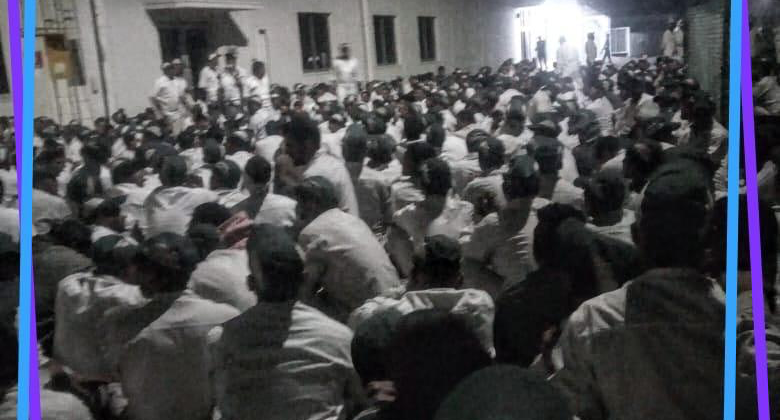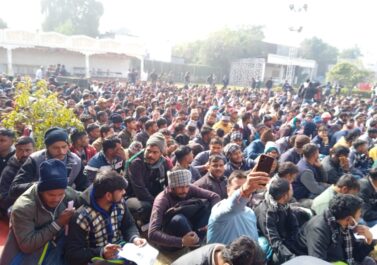The global undercurrents of class struggle are not always immediately visible. We see waves of protests erupting in Chile, Honduras, Iraq and Lebanon, which don’t refer to each other in any obvious ways. While there might not be any conscious mass communication between these movements (yet), we can reasonably assume that they are more than just the result of economic downturns, the global ripples of which have impacted negatively on working class consumption.
These struggles take clues from each other, as past examples have shown us. Do you remember the striking migrant warehouse workers from north Africa who blocked a TNT depot in Italy during the so-called Arab spring, shouting “Down with Mubarak, down with the bosses?” They felt that if the poor can take on a police state ‘at home’ they would surely be able to take on a global logistics company. Do you remember the Maruti Suzuki workers in Manesar, who left their factory after five days of a sit-down strike in 2011 and who, when re-entering the outside world and seeing that Occupy had occupied Wall Street at the same time, said: “It seems our struggle has spread!”.
The current factory occupation of the Honda Manesar plant has its own local history and reference points. The older workers in the plant might remember the brutal police attack in 2005 [1], shortly after the factory was opened. They might remember the wildcat strike of temporary workers in 2010 [2] after the union of permanent workers was established. The temps struck against a management-union agreement which excluded them and based the bonus of the permanent workers on the productivity increases squeezed out of the temps. Many will have taken their clues from the 2011 occupation of both temps and permanents at the neighbouring Maruti Suzuki [3] plant or the wave of wildcat actions in 2014. [4]
And again there are links beyond the immediate local experience. The automobile industry is at the heart of a global crisis, not only in terms of profits or sales, but in terms of the legitimacy of the entire polluting and exploiting system. So it is no coincidence that there was a recent workers’ offensive in the automobile sector on both sides of the US – Mexican wall. The special-economic zones in Mexico were shaken by wildcat strikes in the supply-chain [5]. These struggles on the ‘low-wage’ side of the wall will have encouraged General Motors workers in the US to attack the divisive two-tier system, which their union had agreed to, a few months later. [6]
While large parts of the left still focus on the ‘representatives of evil’ personified by Trump or Modi or the ‘saviours’ in form of Corbyn or Sanders, workers must, and have, taken steps beyond representation. Over the last few months, their protests have questioned ‘leftist’ governments in Bolivia as much as ‘right-wing’ governments in Hungary. What we lack is a collective reflection of the inner-dynamics and global dimension of the current protests. We lack a vision of how to go beyond the clash with state forces and to imagine a collective take-over of the means to produce a better life. This is why struggles such as the current factory occupation of Honda workers are of essential importance. They are literally occupying the means to produce, and in doing so, finding new ways to develop collective knowledge.
Our information regarding this struggle are patchy, we rely on comrades who visited the workers at the gate, and who are in touch with them through WhatsApp, and a few press articles and videos. [7]
The struggle
The sales of Honda scooters and motorcycles are down. Management planned to sack workers hired through contractors first. Some of them had worked there for ten years. Management talked about a three month break, after which they would consider re-hiring workers – by avoiding a formal dismissal they get around paying redundancy pay. The first workers were sacked in batches. Some workers hired through contractors reacted with a boycott of the canteen in October, which has significant symbolic weight.
There are in total around 4,000 workers employed, 2,500 of them through contractor. The plant has an annual capacity of 1.5 million units. Output has recently been cut by 50 per cent. The temps are paid around Rs 14,000 per month, while the permanents get four to five times as much. Although this wage gap has proven to be a fairly reliable tool of divide and rule, currently permanent workers are disgruntled due to delayed pay negotiations. They express solidarity with the action of the temps.
5th of November
Management refuses entry to 400 workers hired through contractors. Inside, some workers start a sit-down protest in front of the union office. Negotiations between union, management and government have no results. The company puts a copied court order up at the gate saying that workers have to stay 200 metres away from the gate, but workers don’t pay any attention.
6th of November
The day shift starts with a sit-down strike inside the factory at 11:30am. Police arrive and threaten individual workers. The late shift is let into the factory and joins the sit-down, while the morning shift refuses to leave. Thousands are inside and 300 workers gather outside of the gate. There are in total 2,500 workers hired through contractor employed at Honda.
7th of November
Management circulates a notice to the permanent workers that the workers hired through contractors are engaged in an illegal sit-down strike and that therefore production is suspended. They tell the permanents to stay at home. Management stops the food supply to the canteens, workers arrive with food at gates. The sit-down continues.
10th of November
Still around 2,000 workers inside. Management publishes the following statement:
Dear Associate,
Due to prevailing IR situation in the plant operations have been suspended and plant will remain closed till the further intimation to you.
Regards
Naveen Sharma
AGM- General Affairs
Manesar Plant
——-
[1]
https://gurgaonworkersnews.wordpress.com/gurgaonworkersnews-no7/#fn4
[2]
https://gurgaonworkersnews.wordpress.com/gurgaonworkersnews-no-935/#fn5
[3]
https://gurgaonworkersnews.wordpress.com/gurgaonworkersnews-no-951/
[4]
[5]
https://www.wsws.org/en/articles/2019/01/26/mata-j26.html
[6]
https://www.foxbusiness.com/markets/gm-strike-sends-ripples-across-auto-parts-suppliers
[7]
https://www.youtube.com/watch?v=I8KZtwKRNsA
https://www.youtube.com/watch?v=GGwhCSPb8go
https://www.youtube.com/watch?v=gUjV4eBoQsw



